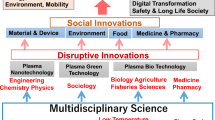Abstract
This article studied the resistance of the negative electron resist based on hydrogen-silsesquioxane (HSQ) depending on the dose of exposure in the process of Reactive Ion Etching (RIE). These studies showed the strong dependence of resistance on irradiation dose (in case of full development of the e-beam resist) even after annealing the resist 30 minutes 400°C in air. Selectivity up to 14 was obtained in the process of reactive ion etching of silicon in a mixture of gases SF6: C4F8. These results can be used to manufacturing of silicon nanoscale structures. It was shown that the resistance to wet etching in a 5% solution of hydrofluoric acid (HF) is also determined by irradiation dose. Additionally, taking into account the obtained results, silicon nanowires of width 10 nm with an aspect ratio of 1: 10 was manufactured.
Similar content being viewed by others
References
Junarsa, I., Stoykovich, M.P., Nealey, P., Ma, Y., Cerrina, F., and Solak, H.H., Hydrogen silsesquioxane as a high resolution negative-tone resist for extreme ultraviolet lithography, J. Vac. Technol. B, 2005, vol. 23, p.138.
Matsui, S., Igaku, Y., Ishigaki, H., Fujita, J., Ishida, M., Ochiai, Y., Namatsu, H., and Komuro, M., Roomtemperature nanoimprint and nanotransfer printing using hydrogen silsequioxane, J. Vac. Technol. B, 2003, vol. 21, p.688.
Nakamatsu, K., Watanabe, K., Tone, K., Katase, T., Hattori, W., Ochiai, Y., Matsuo, T., Sasago, M., Namatsu, H., Komuro, M., and Matsui, S., Bilayer resist method for room-temperature nanoimprint lithography, Jpn. J. Appl. Phys., 2004, vol. 43, pp. 4050–4053.
Olynick, D.L., Cord, B., Schipotinin, A., Ogletree, D.F., and Schuck, P.J., Electron-beam exposure mechanisms in hydrogen silsesquioxane investigated by vibrational spectroscopy and in situ electron-beam-induced desorption, J. Vac. Technol. B, 2010, vol. 28, p.581.
Namatsu, H., Yamaguchi, T., Nagase, M., Yamazaki, K., and Kurihara, K., Nanopatterning of a hydrogen silsesquioxane resist with reduced line width fluctuations, Microelectron. Eng., 1998, vols. 41–42, pp. 331–334.
Yang, J.K.W. and Berggren, K.K., Using high-contrast salty development of hydrogen silsesquioxane for sub-10 nm half-pitch lithography, J. Vac. Technol. B, 2007, vol. 25, no. 6, p. 2025.
Yang, J.K.W., Cord, B., Duan, H., Berggrena, K.K., Klingfus, J., Nam, S.-W., Kim, K.-B., and Rooks, M.J., Understanding of hydrogen silsesquioxane electron resist for sub-5-nm-half-pitch lithography, J. Vac. Technol. B, 2009, vol. 27, no. 6, pp. 2622–2627.
Maier, S.A., Plasmonics: Fundamentals and Applications, New York: Springer, 2007.
Duan, H., Hu, H., Hui, H.K., Shen, Z., and Yang, J.K.W., Free-standing sub-10 nm nanostencils for the definition of gaps in plasmonic antennas, Nanotechnology, 2013, vol. 24, p. 185301.
Franklin, A.D., Luisier, M., Han, S.J., Tulevski, G., Breslin, C.M., Gignac, L., Lundstrom, M.S., and Haensch, W., Sub-10 nm carbon nanotube transistor, Nano Lett., 2012, vol. 12, no. 2, pp. 758–762.
Li, T., Hu, W., and Zhu, D., Nanogap electrodes, Adv. Mater., 2010, vol. 22, pp. 286–300.
Khabutdinov, R., Semenikhin, I., Davydov, F., Svintsov, D., Vyurkov, V., Fedichkin, L., Rudenko, K., Borzdov, A.V., and Borzdov, V.M., Low-dimensional transit-time diodes for terahertz generation, Proc. SPIE, 2016, vol. 10224, p. 102240M.
Trellenkamp, St., Moers, J., van der Hart, A., Kordos, P., and Lüth, H., Patterning of 25-nm-wide silicon webs with an aspect ratio of 13, Microelectron. Eng., 2003, vols. 67–68, pp. 376–380.
Larrieu, G. and Dubois, E., Reactive ion etching of a 20 nanometers tungsten gate using a SF6/N2 chemistry and hydrogen silsesquioxane hard mask resist, J. Vac. Technol. B, 2005, vol. 23, no. 5, pp. 2046–2050.
Yang, J.K.W., Anant, V., and Berggren, K.K., Enhancing etch resistance of hydrogen silsesquioxane via postdevelop electron curing, J. Vac. Technol. B, 2006, vol. 24, no. 6, p. 3157.
Author information
Authors and Affiliations
Corresponding author
Additional information
Original Russian Text © A.V. Miakonkikh, N.A. Orlikovskiy, A.E. Rogozhin, A.A. Tatarintsev, K.V. Rudenko, 2018, published in Mikroelektronika, 2018, Vol. 47, No. 3.
Rights and permissions
About this article
Cite this article
Miakonkikh, A.V., Orlikovskiy, N.A., Rogozhin, A.E. et al. Dependence of the Resistance of the Negative e-Beam Resist HSQ Versus the Dose in the RIE and Wet Etching Processes. Russ Microelectron 47, 157–164 (2018). https://doi.org/10.1134/S1063739718030101
Received:
Published:
Issue Date:
DOI: https://doi.org/10.1134/S1063739718030101




